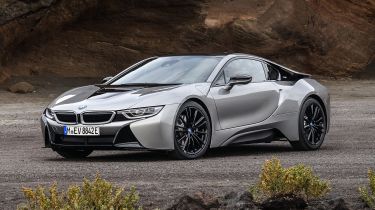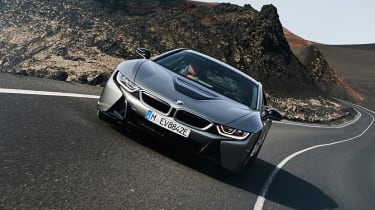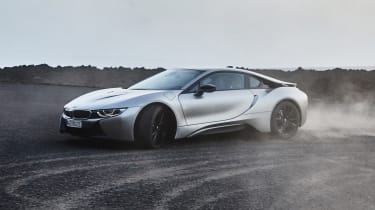BMW i8 (2104-2020) review - Engines, performance and drive
The hybrid setup isn’t necessarily original, but this is the most exciting one there’s ever been – the i8 drives like a supercar

A sports car with a three-cylinder engine doesn’t sound like the most thrilling prospect in the world, but thanks to the assistance of an electric motor, the i8 feels every bit as quick as most of its rivals.
Officially, 0-62mph takes 4.4 seconds – or 4.6 in the Roadster – but thanks to the instant torque of the electric motor, it actually feels a lot faster in the real world. It doesn’t matter what gear you’re in – the i8 comes as standard with a six-speed automatic transmission – the i8 responds instantly to every prod of the throttle.
The i8’s nature as part-supercar, part-eco car means it has different driving modes that affect how the engine and electric motor interact with each other. So, slot the gearlever to the left into Sport mode you get the petrol engine running all the time, the full output from the electric motor, firmer settings for the dampers and more aggressive power steering.
Keep it in Comfort or Eco Pro mode, though, and the i8 will try and run on electric power alone, bringing in the petrol engine only when you accelerate aggressively or go above 45mph. The eco-friendly eDrive setting gives you pure electric running for up to 34 miles, and raises the maximum speed to 75mph.
Used - available now

2018 Mazda
6 Saloon
26,134 milesManualPetrol2.0L
Cash £14,063
2020 MINI
Countryman
31,160 milesAutomaticDiesel2.0L
Cash £16,587
2018 BMW
X5
48,752 milesAutomaticDiesel3.0L
Cash £24,606
2020 Volvo
XC60
53,700 milesAutomaticPetrol2.0L
Cash £20,406Using just the electric motor, you’ll find acceleration comparable to a hot hatch. Flooring the throttle gives you a smooth and muscular surge of acceleration, accompanied by a sci-fi whine from the electric motor and a deep, throaty growl from the three-cylinder engine.
Adding to the sensation of speed is the automatic gearbox, which delivers seamless changes to create the illusion of an uninterrupted wave of acceleration.
• Best sports cars to buy right now
Guide the i8 through a series of bends and it feels light on its feet, with barely any body roll and a crisp response from the fingertip-light steering. Unlike some rivals that feel as if they are pummeling the road into submission, the BMW is more delicate and measured, requiring only small inputs from the driver.
Once you’re actually in the corner, you’ll find the i8 isn’t as engaging or as adjustable as a 911 or Audi R8, but it’s seriously capable nonetheless.
Thanks to the standard adaptive dampers, ride comfort is pretty good, while the BMW’s aerodynamic styling – it boasts a drag coefficient of just 0.26 – means there’s very little wind noise. However, despite its skinny tyres, the i8 generates quite a bit of road roar – although no worse than in a Porsche 911.
Engines
There’s only one drivetrain to speak of, but as it’s so groundbreaking and so central to the existence of the i8, it’s worth expanding on.
A three-cylinder turbo petrol engine – which, with 228bhp, is boosted to roughly 100bhp more than it has in the MINI Cooper – is located mid-rear, behind the driver. It powers the rear wheels.
The electric motor, with 141bhp, is in front of the driver and powers the front axle. That gives the i8 all-wheel drive, with the motors able to work together or independently of each other. Clever software ensures that during gentle driving the electric motor, which draws power from a lithium-ion battery pack, assists the petrol motor in using as little fuel as possible.
On the other hand, during more aggressive driving the two combine forces fully, with the electric motor serving up instant torque for a quick getaway then helping the i8 achieve its 369bhp maximum output.
If that output doesn’t sound like much in this context, that’s because it isn’t – the latest entry-level Audi R8 develops 562bhp – but the i8 is very light for a hybrid, so it doesn’t need masses of power.
Clever tuning means that the i8 sounds a little like a Porsche flat-six from the inside, particularly in Sport mode when the electronically enhanced soundtrack – piped into the cabin through the stereo speakers – is turned up to full volume.









